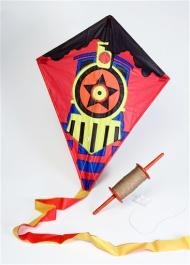 The Strong National Museum of Play in Rochester, NY, U.S.A. selected the kite as one of the three items added to it's Hall of Fame for 2007. The 'kite' joins the other two award winning toys to receive recognition in the Museum's roster of significant toys that have made a lasting mark on the world of play. The other two toy items inducted were: the Raggedy Andy doll and the revolutionary 1977 Atari video game, the first of its kind in the world.
The Strong National Museum of Play in Rochester, NY, U.S.A. selected the kite as one of the three items added to it's Hall of Fame for 2007. The 'kite' joins the other two award winning toys to receive recognition in the Museum's roster of significant toys that have made a lasting mark on the world of play. The other two toy items inducted were: the Raggedy Andy doll and the revolutionary 1977 Atari video game, the first of its kind in the world.
In the Hall of Fame for inducted toys at the museum, the kite is described as follows:
According to tradition, kites made of silk and bamboo first appeared in China some 3,000 years ago, but the earliest written account of kite flying is about 200 BCE. A Chinese general used a kite to determine the distance his troops needed to tunnel under a city’s walls. Kite flying spread throughout Asia and became a national pastime in several countries. From Asia, kites continued to migrate to the rest of the world. In the English language, kites share their name with a graceful and colorful hawk.
Though the aerodynamics of kites remain the same, the materials, shapes, and uses of kites have multiplied throughout the centuries. Ancient Chinese kites made of silk and bamboo have given way to kites of paper, polyester, and rip-stop nylon. Flat kites with diamond or geometric shapes share the skies with intricate box kites and other three-dimensional forms and inflatable spar-less airfoils. Over the years, kites have advanced science, meteorology, building construction, and photography. Modern enthusiasts use kites for sports like hang-gliding and competitive kite fighting, and in traditional and national festivals. Other people use kites just for fun. Nothing sends the human spirit soaring so well as a colorful kite aloft in a gentle breeze.
The kite certainly meets the criteria outlined by the Museum's Hall of Fame:
Toys build physical and mental skills; foster creativity and imagination; encourage critical and strategic thinking; teach fair play and cooperation; connect kids and adults; hold memories and provide windows into the past; reflect the ideas, beliefs, values, and attitudes of their creators and users; reveal historical change; predict the future; educate and entertain.
For more details see the Associated Press story by reporter Ben Dobbin entitled: Atari 2600, Raggedy Andy, Kite Enshrined.